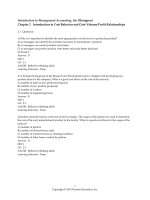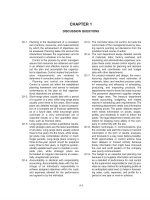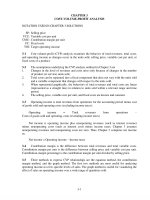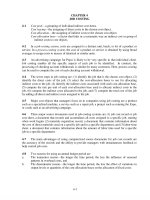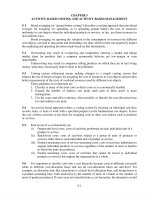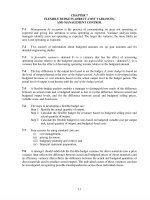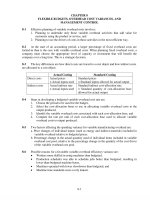Solution manual introduction to management accounting 14e by horngren ch01
Bạn đang xem bản rút gọn của tài liệu. Xem và tải ngay bản đầy đủ của tài liệu tại đây (329.47 KB, 39 trang )
To download more slides, ebook, solutions and test bank, visit
CHAPTER 1
COVERAGE OF LEARNING OBJECTIVES
LEARNING OBJECTIVE
LO1: Describe the major users
and uses of accounting
information.
LO2: Explain why ethics is
important to management
accountants.
LO3: Describe the cost-benefit
and behavioral issues involved
in designing an accounting
system.
LO4: Explain the role of
budgets and performance
reports in planning and
control.
LO5: Discuss the role
accountants play in the
company’s value chain
functions.
LO6: Contrast the functions of
controllers and treasurers.
LO7: Explain why accounting
is important in a variety of
career paths.
LO8: Identify current trends in
management accounting.
LO9: Appreciate the importance of ethical conduct to
professional accountants.
FUNDACRITICAL
MENTAL
THINKING
ASSIGNEXERCISES
MENT
AND
MATERIAL EXERCISES
A1, B1
33
CASES,
EXCEL,
COLLAB.,
&
PROBLEMS INTERNET
EXERCISES
39, 40, 42
55
A3
37, 38
47, 49, 40
51, 55
41, 43
A2, B2
32
45
A1, B1
30, 31, 34, 35, 39, 42, 44
36
B3
29, 36
39, 45, 46
30, 31
53
50
52, 55
54
A3, B4
37, 38
1
47, 48, 49
51, 52, 55
To download more slides, ebook, solutions and test bank, visit
CHAPTER 1
Managerial Accounting, the Business Organization, and
Professional Ethics
1-A1 (10-15 min.)
Because the accountant's duties often are not sharply defined,
some of these answers could be challenged:
1.
Scorekeeping. Determining a depreciation schedule is simply
an exercise in preparing financial statements to report the
results of activities.
2.
Problem solving. Helps a manager assess the impact of a
decision.
3.
Scorekeeping. Reports on the results of an operation. Could
also be attention directing if scrap is an area that might require
management decisions.
4.
Attention directing. Focuses attention on areas that need
attention.
5.
Attention directing. Helps managers learn about the
information contained in a performance report.
6.
Scorekeeping. The statement merely reports what has
happened.
7.
Problem solving. The cost comparison is apparently useful
because the manager wishes to decide between two
alternatives. Thus, it aids problem solving.
8.
Attention directing. Variances point out areas where results
differ from expectations. Interpreting them directs attention to
possible causes of the differences.
9.
Problem solving. Aids a decision about where the parts should
be made.
10. Attention directing and problem solving. Budgeting involves
making decisions about planned activities -- hence, aiding
problem solving. Budgets also direct attention to areas of
opportunity or concern --hence, directing attention. Reporting
against the budget also has a scorekeeping dimension.
2
To download more slides, ebook, solutions and test bank, visit
1-A2 (15-20 min.)
1.
Budgeted
Amounts
Room rental $ 140
Food
700
Entertainment 600
Decorations
220
Total
$1,660
Actual
Amounts
$ 140
905
600
190
$1,835
Deviations
or Variances
$ 0
205U
0
30F
$175U
2.
Because of the management by exception rule, room rental and
entertainment require no explanation. The actual expenditure
for food exceeded the budget by $205. Of this $205, $150 is
explained by attendance of 15 persons more than budgeted (at
a budget of $10 per person) and $55 is explained by
expenditures above $10 per person.
Actual expenditures for decorations were $30 less than the
budget. If all desired decorations were purchased, the
decorations committee should be commended for their savings.
3
To download more slides, ebook, solutions and test bank, visit
1-A3 (10 min.)
All of the situations raise possibilities for violation of the integrity
standard. In addition, the manager in each situation must address
an additional ethical standard:
1.
2.
3.
The General Mills manager must respect the confidentiality
standard. He or she should not disclose any information about
the new cereal.
Felix must address his level of competence for the assignment.
If his supervisor knows his level of expertise and wants an
analysis from a “layperson” point of view, he should do it.
However, if the supervisor expects an expert analysis, Felix
must admit his lack of competence.
The credibility standard should cause Mary Sue to decline to
omit the information from her budget. It is relevant
information, and its omission may mislead readers of the
budget.
4
To download more slides, ebook, solutions and test bank, visit
1-B1 (15-20 min.)
Because the accountant’s duties often are not sharply defined,
some of these answers could be challenged:
1.
2.
3.
4.
5.
6.
7.
8.
9.
10.
11.
12.
13.
14.
15.
Problem solving. Provides information for deciding between
two alternative courses of action.
Scorekeeping. Simply recording of what has happened.
Problem solving. Helps a manager decide between
alternatives.
Attention directing. Directs attention to the use of overtime
labor.
Problem solving. Provides information to managers for
deciding whether to move corporate headquarters.
Attention directing. Directs attention to why nursing costs
increased.
Attention directing. Directs attention to areas where actual
results differed from the budget.
Problem solving. Helps the vice-president to decide which
course of action is best.
Problem solving. Produces information to help the marketing
department make a decision about a marketing campaign.
Scorekeeping. Records actual overtime costs.
Attention directing. Directs attention to stores with either high
or low ratios of advertising expenses to sales.
Attention directing. Directs attention to causes of returns of
the drug.
Attention directing or problem solving, depending on the use of
the schedule. If it is to identify areas of high fuel usage it is
attention directing. If it is to plan for purchases of fuel, it is
problem solving.
Scorekeeping. Records events.
Scorekeeping. Records items needed for financial statements.
5
To download more slides, ebook, solutions and test bank, visit
1-B2 (10-15 min.)
1 & 2.
Sales
Costs:
Fireworks
Labor
Other
Total cost
Profit
3.
Budget
Actual Variance
$75,000 $74,860$ 140U
$36,000
15,000
8,000
59,000
$16,000
$39,500
13,000
8,020
60,520
$14,340
$3,500U
2,000F
20U
1,520U
$1,660U
The cost of fireworks was $3,500 ÷ $36,000 = 9.7% over
budget. Did fireworks suppliers raise their prices? Did
competition cause retail prices to be lower than expected?
There should be some explanation for the extra cost of
fireworks. Also, the labor cost was $2,000 ÷ $15,000 =13.3%
below budget. It would be useful to discover why this cost was
saved. Both sales and other costs were very close to budget.
1-B3 (10 - 15 min.)
1.
2.
3.
4.
5.
6.
7.
8.
Controller. Divisional financial statements report on
operations. Financial statements are generally produced by
the controller's department.
Controller. Advising managers aids operating decisions.
Controller. Advice on cost analysis aids managers' operating
decisions.
Treasurer. Analysts affect the company's ability to raise
capital, which is the responsibility of the treasurer.
Treasurer. Financing the business is the responsibility of the
treasurer.
Controller. Tax returns are part of the accounting process
overseen by the controller.
Treasurer. Insurance, as with other risk management
activities, is usually the responsibility of the treasurer.
Treasurer. Allowing credit is a financial decision.
6
To download more slides, ebook, solutions and test bank, visit
1-B4 (15 - 20 min.)
1.
A code of conduct is a document specifying the ethical
standards of an organization .
2.
Different companies include different elements in their codes of
conduct. Some of the items included in companies’ codes of
conduct include maintaining a dress code, avoiding illegal
drugs, following instructions of superiors, being reliable and
prompt, maintaining confidentiality, not accepting personal
gifts from stakeholders as a result of company role, avoiding
racial or sexual discrimination, avoiding conflict of interest,
complying with laws and regulations, not using organization’s
property for personal use, not discriminating against race or
age or sexual orientation, and reporting illegal or questionable
activity. Some companies have a simple code with little detail,
and others have long lists of rules and regulations regarding
appropriate conduct. The key is that the code of conduct must
fit with the corporate culture.
3.
Simply having a code of conduct does not guarantee ethical
behavior by employees. Most important is top management’s
ethical example and its support of the code of conduct. A
company’s performance evaluation and reward system must be
consistent with its code of conduct. If unethical actions are
rewarded, they will be encouraged even if they violate the code
of conduct.
7
To download more slides, ebook, solutions and test bank, visit
1-1 Internal managers and external parties (for example, investors
and government authorities) use accounting information for three
broad purposes:
1.
2.
3.
Internal reporting to managers for planning and controlling
operations.
Internal reporting to managers for special decision-making
and long-range planning.
External reporting to stockholders, government, and other
interested parties.
1-2 The emphasis of financial accounting has traditionally been on
the historical data presented in the external reports. Management
accounting emphasizes planning and control purposes.
1-3 The branch of accounting described in the quotation is
management accounting.
1-4 Scorekeeping is the recording (including accumulation and
classification) of data for a later evaluation of performance.
Attention directing is the reporting and interpretation of
information for the purpose of focusing on inefficiencies of
operation, opportunities for improvement, and imperfections and
operating problems. Problem solving presents a concise analysis of
alternative courses of action and recommends the best course of
action.
1-5 No. GAAP applies to publicly issued annual financial reports.
Internal accounting reports are not restricted by GAAP.
1-6 Yes, but it covers more than that. The Foreign Corrupt
Practices Act applies to all publicly-held companies and covers the
quality of internal accounting control as well as bribes and other
matters.
8
To download more slides, ebook, solutions and test bank, visit
1-7 Many managers believe that the costs of applying the
provisions of the Sarbanes-Oxley act are greater then the benefits.
This is especially true about the mandated auditing of companies’
internal control systems.
1-8 Users cannot easily observe the quality of accounting
information. Thus, they rely on the integrity of accountants to be
sure the information is accurate. Information that is unreliable is
worthless, so if accountants do not have a reputation for integrity,
the information they produce will not have value.
1-9 No. The ethics developed as a student carry over into one’s
professional life. Integrity is important at all stages of development.
Students who use unethical means to achieve success are likely to try
similar methods when in business.
1-10 Three examples of service organizations are banks, insurance
companies, and public accounting firms. Such organizations tend to
be labor intensive, have outputs that are difficult to define and
measure, and have both inputs and outputs that are difficult or
impossible to store.
1-11 Two considerations are cost-benefit balance and behavioral
effects. Cost-benefit balance refers to how well an accounting
system helps achieve management's goals in relation to the cost of
the system. The behavioral consideration specifies that an
accounting system should be judged by how it will affect the
behavior (that is, decisions) of managers.
1-12 Yes. The act of recording events has become as much a part of
operating activities as the act of selling or buying. For example,
cash receipts and disbursements must be traced, and receivables and
payables must be recorded, or else gross confusion would ensue.
9
To download more slides, ebook, solutions and test bank, visit
1-13 A budget is a quantitative expression of a plan of action; a
performance report compares actual results compared with the
budget; and a variance measures the differences between budget
and actual.
1-14 No. Management by exception means that management spends
more effort on those areas that seem to be out of control and less on
areas that are functioning as planned. This method is an efficient
way for managers to decide where to put their time and effort.
1-15 Information that is relevant for decisions about a product
depends on the product's life-cycle stage. Therefore, to prepare and
interpret information, accountants should be aware of the current
stage of a product's life cycle.
1-16 The six functions are: (1) research and development –
generation and experimentation with new ideas for products,
services, or processes; (2) product, service, and process design –
detailed design and engineering of products, services, or processes;
(3) production – use of resources to produce a product or service; (4)
marketing - informing customers of the value and features of
products or services; (5) distribution – delivering products or
services to customers; and (6) customer service – support provided
to customers.
1-17 No. Not all of the functions are of equal importance to the
success of a company. Measurement and reporting should focus on
those functions that enable a company to gain and maintain a
competitive edge. In addition, some functions in the value chain
may not be present in some organizations.
10
To download more slides, ebook, solutions and test bank, visit
1-18 Line managers are directly responsible for the production and
sale of goods or services. Staff managers have an advisory function
– they support line managers.
1-19 Management accountants are the information specialists, even
in non-hierarchical companies. However, in such companies they
are more directly involved with managers and are often parts of
cross-functional teams.
1- 20 A treasurer is concerned mainly with the company's financial
matters, the controller with operating matters. In large
organizations, there are sufficient activities associated with both
financial and operating matters to justify two separate positions. In
a small organization the same person might be both treasurer and
controller.
1-21 The four parts of the CMA examination are: (1) business
analysis, (2) management accounting and reporting, (3) strategic
management, and (4) business applications.
1-22 This is not true. About one-third of CEOs in companies with
revenues greater than $500 million come from finance or accounting
backgrounds. Accounting is excellent preparation for top
management positions because accountants are often exposed to
many parts of the company early in their careers.
11
To download more slides, ebook, solutions and test bank, visit
1-23 Changes in technology are affecting how accountants operate.
Increasing computer capabilities and decreasing computer costs
have changed how accountants gather, store, manipulate, and report
data. Today accountants work with managers to get needed
information. Among other things, they must be able to account for
e-commerce transactions efficiently and safely, they often must
integrate their accounting systems into ERP systems, and an
increasing number are beginning to use XBRL to communicate
information electronically.
1-24 The essence of the just-in-time philosophy is the elimination of
waste, accomplished by reducing the time products spend in the
production process and trying to eliminate the time spent in
activities that do not add value to the product.
1-25 Moving tools and products that are in process from one
location to another in a plant is an activity that does not add value to
the product. So changing the plant layout to eliminate wasted
movement and time improves production efficiency.
1-26 Six Sigma is an important management philosophy, and it has
important implications for management accountants. Management
accountants play a major role in Six Sigma applications as both the
experts on the measurements being used and as full members of the
cross-functional teams that lead the efforts.
12
To download more slides, ebook, solutions and test bank, visit
1-27 The four major responsibilities are: (1) competence - develop
knowledge; know and obey laws, regulations, and technical
standards; and perform appropriate analyses, (2) confidentiality refrain from disclosing or using confidential information, (3)
integrity - avoid conflicts of interest, refuse gifts that might influence
actions, recognize limitations, and avoid activities that might
discredit the profession, and (4) credibility - communicate
information fairly, objectively, and completely, within
confidentiality constraints.
1-28 Standards do not always provide the needed guidance.
Sometimes an action borders on being unethical, but it is not clearly
an ethical violation. Other times two ethical standards conflict. In
situations such as these, accountants must make ethical judgments.
1-29 (5-10 min.)
Typical activities associated with the treasurer function include:
Provision of capital
Investor relations
Short-term financing
Banking and custody
Credit management and collections of cash
Investments
Risk management
Typical activities associated with the controller function include:
Planning for control
Reporting and interpreting
Evaluating and consulting
Tax administration
Government reporting
Protection of assets
Economic appraisal
13
To download more slides, ebook, solutions and test bank, visit
1-30 (5-10 min.)
Activities 2, 4, 5, and 6 are primarily associated with marketing
decisions.
The management accountant would assist in these decisions as
follows:
Airbus’s pricing decision requires cost data relevant to the new
method of distributing spare parts. Amazon.com will need to know
the costs of the advertising program as well as the additional costs of
other value chain functions resulting from increased sales. TexMex
Foods will need to know the incremental revenues and incremental
costs associated with the special order. Target Stores needs to know
the impact on both revenues and costs of closing one of its stores.
1-31 (5-10 min.)
Activities 1, 7, and 8 are primarily associated with production
decisions.
The management accountant would assist in these decisions as
follows.
Saab needs an analysis of the costs associated with purchasing the
part compared to the costs of making the part. Dell will need to
know the costs of the training program and the savings associated
with increased efficiencies in the setup and changeover activities.
Ford needs to know the costs and salvage values of the replacement
equipment, the proceeds of the sale of the old equipment, and the
operating savings associated with the use of the new equipment.
14
To download more slides, ebook, solutions and test bank, visit
1-32 (5 min.)
1. Management
2. Management
3. Financial
4. Management
5. Management
6. Financial
7. Financial
1-33 (10 min.)
1. Performance Report
Budget
Actual Variance
Explanation
Revenues
$330,000 $328,000 $(2,000) U Additional sales
from new
products*
Advertising cost
30,000
32,500
(2,500) U New advertising
campaign
Net
$4,500 U
* From the New Products Report, seven new products were added.
This exceeded the plan to add six.
2. Factors that may not have been considered include:
a. The costs of new products may have exceeded their price.
b. Customer satisfaction with new products may not have been
part of the new products report.
c. Competitors’ reactions to the Starbucks store’s actions may
not have been anticipated.
d. External uncontrollable factors such as increases in
operating costs, adverse weather, changes in the overall
economy, new competitors entering the market, or key
employee turnover may have decreased efficiency.
15
To download more slides, ebook, solutions and test bank, visit
1-34 (5 min.)
1. Line, support
2. Line, marketing
3. Staff, marketing
4. Staff, support
5. Staff, support
6. Line, production
1-35 (30 min.)
Microsoft is a company that most students will know and have
some understanding of what functions its managers perform.
Nevertheless, this may not be an easy exercise for those who have
little knowledge of how companies operate.
Research & development – Because software companies must
continually come out with new products and upgrades to their
current products, this is a critical function for Microsoft. More than
one-fourth of Microsoft’s operating expenses are devoted to R&D.
Design of products, services, or processes – For Microsoft the design
and R&D process probably overlap considerably. Product design is
critical; process design is probably not. One essential part of design
is beta testing – that is, field testing of new software. This qualitycontrol step is essential to prevent customer dissatisfaction with new
products.
Production – Microsoft produces disks and CD-ROMs and the
manuals and packaging to go with them. However, they are
increasingly delivering software over the Internet, which takes an
initial process design and then few resources. It is not likely a major
focus for Microsoft.
16
To download more slides, ebook, solutions and test bank, visit
Marketing – Microsoft spends more on sales and marketing than on
any other operating expense. Increasing competition in software
sales makes marketing essential to the company’s future. This
function includes advertising and direct marketing activities, but it
also includes activities of the company’s sales force.
Distribution – This function is becoming simpler for Microsoft as it
delivers more and more software over the Internet. Although the
company must stay abreast of competitors in delivery methods, this
is not likely to create a major competitive advantage or
disadvantage for Microsoft.
Customer service – Customer service is important, but Microsoft
tries to minimize its costs in this area by product design – making
things work right without needing deep computer expertise. Still,
poor customer service can severely impact a company, so Microsoft
must attend to it.
Support functions – Most of the time these are not a major focus.
There is one exception recently for Microsoft. Legal support has
been front and center. The very future of the company was based
on court judgments for which good legal support was essential.
1-36 (15-20 min.)
The management accountant's major purpose is to provide
information that helps line managers in making decisions regarding
the planning and controlling of operations. The accountant supplies
information for scorekeeping, attention directing, and problem
solving. In turn, managers use this and other information for
routine and non-routine decisions and for evaluating subordinates
and the performance of sub-parts of the organization. Management
accountants must walk a delicate line between (1) making sure that
managers are properly using the pertinent information and (2)
making sure that the managers, not the accountants, are doing the
actual managing.
17
To download more slides, ebook, solutions and test bank, visit
1-37 (5 min.)
Other costs of a poor ethical environment include legal costs and
costs due to high employee turnover. Other benefits of a good ethical
environment include low employee turnover, low loss from internal
theft, and improved customer satisfaction resulting from better
quality and service (that result from a more productive work
environment).
1-38 (5 min.)
There are numerous examples.
“You understand how important it is to record this sale before year
end, don’t you?”
“Doing it this way is common for all companies in our business, so
don’t worry!”
“Trust me, the inventory is at the warehouse.”
18
To download more slides, ebook, solutions and test bank, visit
1-39 (15-20 min.)
This problem can form the basis of an introductory discussion
of the entire field of management accounting. Text Exhibit 1-1
provides more details.
1.
The focus of management accounting is on helping internal
users to make better decisions, whereas the focus of financial
accounting is on helping external users to make better
decisions. Management accounting helps in making a host of
decisions, including pricing, product choices, investments in
equipment, making or buying goods and services, and manager
rewards.
2.
Generally accepted accounting principles constrain financial
accounting but not management accounting. For example, if
an organization wants to account for assets on the basis of
replacement costs for internal purposes, no outside agency can
prohibit such accounting. Of course, this means that
organizations may have to keep more than one set of records.
There is nothing immoral or unethical about having multiple
sets of books, but they are expensive. Accounting data are
commodities, just like butter or eggs. Innovations in internal
accounting systems must meet the same cost-benefit tests that
other commodities endure. That is, their perceived increases in
benefits must exceed their perceived increases in costs.
Ultimately, benefits are measured by whether managers make
better decisions that result in increased net profits or cost
savings.
3.
Budgets, the formal expressions of management’s plans, are a
major feature of management accounting, whereas they are not
as prominent in financial accounting. Budgets are major
devices for compelling and disciplining management planning.
19
To download more slides, ebook, solutions and test bank, visit
4.
An important use of management accounting information is
the evaluation of performance, which often takes the form of
comparison of actual results against budgets, providing
incentives and feedback to improve future decisions.
5.
Accounting systems have an enormous influence on the
behavior of individuals affected by them. Management
accounting is more concerned with the likely behavioral effects
of various accounting alternatives that may be adopted than is
financial accounting.
1-40 (10 min.)
The main point of this question is that cost information is crucial for
decisions regarding which products and services should be
emphasized or de-emphasized. The incentives to measure costs
precisely are far greater when flat fees are being received instead of
reimbursements of costs.
Note, too, that nonprofit organizations and profit-seeking
organizations have similar desires regarding management
accounting. Accountability is now in fashion for many purposes,
including justification of prices, cost control, and response to
criticisms by investors (whether they be donors, taxpayers, or
others).
When somebody's money is at stake, accounting systems get much
love and attention. In a survey of 550 hospitals, hospital financial
executives said that improved cost accounting systems "are crucial
to responding to changes in hospital payment mechanisms and that
better cost information is essential for more profitable and efficient
operations." Hospitals will increasingly identify costs by product
(type of case), not just by departments.
20
To download more slides, ebook, solutions and test bank, visit
1-41 (10 min.)
Paperwork and systems often seem to become ends in
themselves. However, the rationale that should underlie systems
design is the cost-benefit philosophy or approach that is implied in
the quotation. The aim is to get the managers and their
subordinates collectively to make better decisions under one system
versus another system -- for a given level of costs.
Marks & Spencer should look at each of the management
accounting reports it produces with an eye toward how it helps
managers make better decisions. Does it provide needed
scorekeeping? Does it direct attention to aspects of operations that
might need altering? Does it provide information for specific
management decisions? These types of questions will help identify
the benefit of the information in the report.
Then the company must consider the cost – not just the cost of
collecting the data and preparing the reports, but the cost of
educating managers to use the information and the cost of the time
to read, digest, and act on the information. Too much information
may be costly because it makes it time-consuming (and thus costly)
to sift through the reams of information to find the few items that
are important. An additional cost may be the loss of important
information because the total volume of information makes it too
difficult to ferret out the important items.
21
To download more slides, ebook, solutions and test bank, visit
1-42 (10 min.) Financial information is important in all
companies. But how managers get and use financial information
can differ depending on the culture and philosophies of the
company.
Top executives of a company often represent a functional area
that is critical to the competitive economic advantage of the
company. If technology is crucial, engineers generally hold
important executive positions. If marketing differentiates the
company from others, marketing executives usually dominate. But
regardless of the source of a company’s competitive advantage, its
success will eventually be measured in economic terms. They must
attend to financial aspects to thrive and often even to survive.
Management accountants must work with the dominant
managers in any organization. The modern trend toward use of
cross-functional teams places management accountants at the center
of the action regardless of what type of managers and executives
dominate. Most companies realize that there is a financial
dimension to almost every major decision, so they want the financial
experts, management accountants, involved in the decisions. But to
be accepted as an important part of these teams, the management
accountants must know how to help managers in various functional
areas. In General Mills, if accountants can’t talk the language of
marketing, they will not have great influence. In ArvinMeritor, if
they do not understand the information needs of engineers they will
not provide value.
22
To download more slides, ebook, solutions and test bank, visit
1-43 (10-15 min.)
1. Boeing's competitive environment and manufacturing processes
changed greatly during the 1990s. An accounting system that
served them well in their old environment would not necessarily
be optimal in today. Boeing's management probably thought
that changes in the accounting system were necessary to produce
the kind of information necessary to remain competitive.
2. A cost-benefit criterion was probably used. Boeing's
management may not have quantified the costs and the benefits,
but they certainly assessed whether the new system would help
decisions enough to warrant the cost of the system.
Many of the benefits of a better accounting system are hard to
measure. They affect many strategic decisions of an
organization. Without accurate product costs, management will
find it difficult to assess the consequences of their decisions. An
accurate accounting system will help to price airplanes and other
products competitively.
3. More accurate product costs will usually result in better
management decisions. But if the cost of the accounting system
that produces the more accurate costs is too high, it may be best
to forego the increased accuracy. The benefit of better decisions
must exceed the added cost of the system for a change to be
desirable.
23
To download more slides, ebook, solutions and test bank, visit
1-44 (10 min.)
1.
There are many possible activities for each function of Nike's
value chain. Some possibilities are:
Research and development -- Determining changes in
customers' tastes and preferences for shoes and sportswear to
come up with new products (maybe the next "Air Jordans").
Product, service, and process design -- Design a shoe to meet
the increasing demands of competitive athletes.
Production -- Determine where to produce products and
negotiate contracts with the companies producing them.
Marketing -- Signing prominent athletes to endorse Nike's
products.
Distribution -- Select the best locations for warehouses for
distribution to retail outlets.
Customer service -- Formulate return policies for products that
customers perceive to be defective.
2.
Accounting information that aids managers' decisions includes:
Research and development -- Trends in sales for various
products, to determine which are becoming more and less
popular.
Product, service, and process design -- Production costs of
various shoe designs.
24
To download more slides, ebook, solutions and test bank, visit
Production -- Measure total costs, including both purchase cost
and transportation costs, for production in various parts of the
world.
Marketing -- The added profits generated by the added sales
due to product endorsements.
Distribution -- Storage and shipping costs for different
alternative warehouse locations.
Customer service -- The net cost of returned merchandise, to
be compared with the benefits of better customer relations.
25
